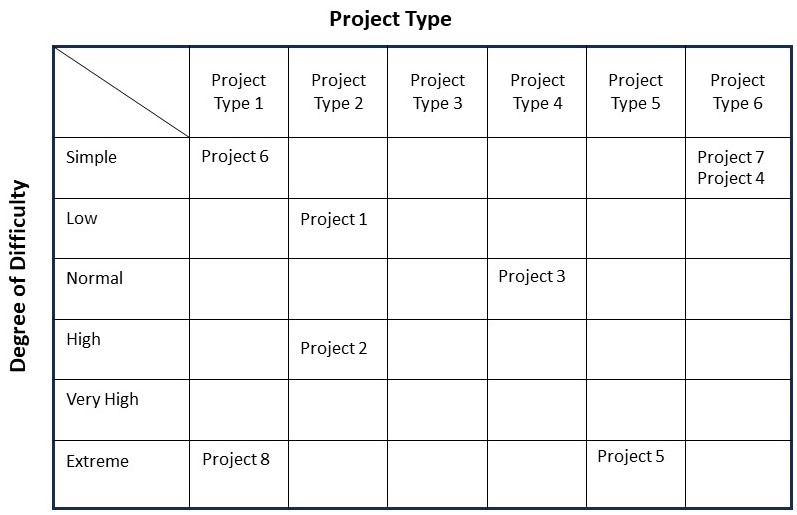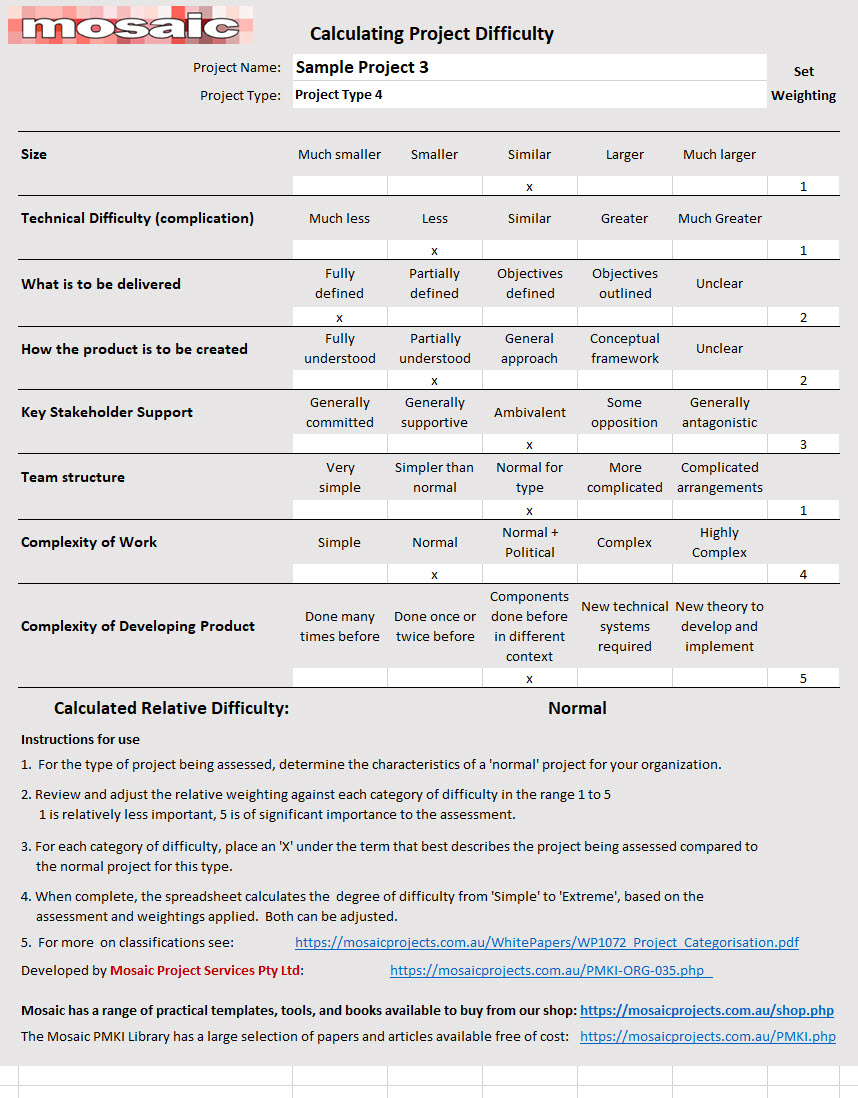Location:
PMKI > Organizations
& Governance > Defining Projects and
Programs.


- Project Definition and Typology
- Definition
- Classification
- Program Definition and Typology
- Definition
- Classification
- Useful External Web-links &
Resources.
Other related sections of the PMKI:
- Delivering Value
and Success
- Vocabulary & Lexicons
 Defining
the nature of a project and its parameters.The definition
of a project used by almost every authority is an
inclusive definition ie; 'a project is a temporary
endeavour undertaken to create a unique product, service
or result' PMBOK(R) Guide. This definition can
apply equally well to genuine projects, other endeavours
(Paul C. Dinsmore 'Everything in business is a project or
project-related') and to processes that are definitely not
projects. Before the true value of projects to an
enterprise can be properly assessed and the
responsibilities of a Project Manager identified, the
definition of "projects" must be tightened so that
endeavours that are not projects are excluded as
effectively as endeavours that are projects are included.
Defining
the nature of a project and its parameters.The definition
of a project used by almost every authority is an
inclusive definition ie; 'a project is a temporary
endeavour undertaken to create a unique product, service
or result' PMBOK(R) Guide. This definition can
apply equally well to genuine projects, other endeavours
(Paul C. Dinsmore 'Everything in business is a project or
project-related') and to processes that are definitely not
projects. Before the true value of projects to an
enterprise can be properly assessed and the
responsibilities of a Project Manager identified, the
definition of "projects" must be tightened so that
endeavours that are not projects are excluded as
effectively as endeavours that are projects are included.
Modifying the definition of a project to distinguish projects from other endeavours suggests a definition along these lines:
Under the enhanced definition proposed in this section, a project can only exist if its stakeholder community agrees. The outcome to be expected from bringing the stakeholder community directly into the project management processes, is to ensure more projects deliver to their full potential to the benefit of their host organizations and the community.
PP: Project Fact or Fiction. Constructing an unambiguous definition the definition of the terms 'project', 'project manager', and 'project management': Project: A temporary organization established to accomplish an objective, under the leadership of a person (or people) nominated to fulfil the role of project manager. And the reasons why this is important.
Blg: Understanding the Iron Triangle and Projects. While the iron triangle has been consigned to history, the original concepts behind the project management triangle, provide a useful framework for defining a project, and separating project management from general management.
Prs: The Entropy at the heart of Project Management. This paper tracks the emergence and convergence of modern project management through to the early part of the 21st century, then maps the rapidly diverging strands that are now encompassed by the concept of ‘project management’. From this basis it seeks to identify the challenges inherent in this increasing entropy, and offer some suggestions for the shape of the profession, associations, and qualifications going forward.
Art: De-Projectising IT Maintenance. Not everything needs to be a project – by de-projectizing maintenance work major improvements in delivery are possible.
 Defining
the different characteristics, types, and sizes of project
and their effect on the skills needed to manage them
effectively is important for organizations that wish to
learn from previous experience to improve the delivery of
current projects. The scope of projects is wide and many
different classification systems can be applied. These are
discussed below.
Defining
the different characteristics, types, and sizes of project
and their effect on the skills needed to manage them
effectively is important for organizations that wish to
learn from previous experience to improve the delivery of
current projects. The scope of projects is wide and many
different classification systems can be applied. These are
discussed below.
WP: Project Size and
Categorization. This White Paper discusses the
overall challenge of project categorization and the
different approaches suggested by authors in the past,
based on classifying projects by type (industry, or other
characteristic), and/or the four basic dimensions to every
project that affect its management: size, difficulty,
uncertainty and complexity.
WP: Designing a
Project Categorization System. Outlines a
pragmatic classification framework that considers the type
of project based on the project’s the organization
typically undertakes and the relative degree of difficulty
of each project within its type:
• The type provides an understanding of
the technology, methods, equipment, and tools needed to
deliver the project.
• The degree of difficulty indicates the
challenges, and therefore the capabilities needed by the
project
team to successfully manage the project.

Assessing project type:
Determining the types to
use and then allocating projects to the appropriate type
classification simply requires an objective
assessment, tailored to the needs of the organization. For
most organizations 5 or 6 project types should be
sufficient - the purpose is to group similar projects to
assist in overall governance and organizational
management, not to specify individual projects. Some
of the options for assessing type are
outlined in WP:
Project Size and Categorization.
Assessing project difficulty:
Calculating the difficulty dimension is more challenging and we have developed a free Excel spreadsheet to assist in the process.
The spreadsheet looks at nine aspects that affect difficulty, and the difficulty ratings are relative to a ‘normal’ (or average) project of this type, not an arbitrary overall ranking. To help in the assessment it is easiest to compare the project being assessed with a known project that is considered to be fairly normal for this type of project rather than imagining an abstract concept. These will be the comparison points for each assessment.
The other requirement is to decide what elements of the assessment are more significant for this type of project, and which as less important, and set the weightings in the spreadsheet where 1= less important and 5= very important. Some aspects of a project are more significant than others, but this changes depending on what the various drivers for success and failure are within the type. Sometimes the team is more important, other times the technology or the stakeholders. The weighting allows the more important factors to have more influence.
Both the basis for assessment
(the 'normal' project), and weightings, should be used
consistently for all projects within the type to
deliver a consistent difficulty ranking.
The final step to assess a project is to take a copy of the weighted spreadsheet and place an X under the option that best describes the project being assessed compared to the ‘normal’ project. There is a detailed explanation of each characteristic and the five assessment points in WP: Designing a Project Categorization System.
As data is entered and edited,
the spreadsheet automatically calculates the difficulty
rating for the project using the six levels of difficulty
described above: Simple, Low, Normal, High, Very High,
Extreme. The calculation is complete once the last data
point is entered and the project can be positioned in the
matrix above.

Art: How should the different types of project management be described ?. This article looks at the challenges of categorizing projects based on project management method being used. It is based on the 2024 PMI classification process of Predictive - Hybrid - Agile and the consequential consigning of waterfall to history.
Blg: Differentiating normal, complex and megaprojects. A look at the additional layers of competency needed to manage complex projects and megaprojects and a suggested framework for classifying these different types of project.
Blg:
Hard -v- Soft Projects. This post offers a
concise definition of hard and soft
projects:
- A hard project is one where the
majority of the work is dependent on a finalized design
being
complete for each element of the project,
prior to work starting on that element.
- A soft project is one where the
majority of the work has a degree of flexibility on how
the
required functionality is achieved.
Blg: Defining Traditional Project Management. Before the start of the 21st century there was only one basic approach to project management outlined in the PMBOK® Guide and many other reference sources. The Agile manifesto changed this forever. This post looks at defining the traditional way of managing projects to provide a basis for comparing other emerging trends and ideas.
Blg: Classifying projects. A look at an updated framework for classifying these different types of project.
Blg: Classifying projects. A look at the constraints affecting the way a project is managed.
Blg: Complicated vs Complex – Understanding Complexity. Estimating, planning, and managing a complex project requires a different approach. This post looks at some of the key differences between managing a complicated project and managing a complex project that affect classification.
PP:
Scheduling Challenges in Agile & Distributed
Projects. The focus of this paper is to define
the challenge and look at practical options for managing
work efficiently in a wide range of projects where the CPM
paradigm does not apply. To facilitate this, it develops a
classification framework of project characteristics to
help define the potential usefulness of CPM scheduling
across different project types. See pages 5 through 7):
1. Physically constrained – there is only one
viable work sequence - The CPM paradigm is ideal for this
type of project.
2. Practically constrained – management has agreed
the one best work sequence. The CPM paradigm is ideal for
this type of project.
3. Overarching constraints – there is a required
overall sequence of working, with a degree of flexibility
in the way the detailed work is performed to achieve the
overall objectives. The CPM paradigm may be useful at the
high level in a Class 3 project, but has significant
limitations at the detail level.
4. Arbitrary constraints – there is no required
sequence of working (as in Class 1 or 2), but management
has decided to impose a detailed sequence of work as a
matter of choice. The CPM paradigm is imposed for little
or no practical benefit.
Defining the nature of a program and its parameters. A
program is defined as a group of related projects managed
in a coordinated way to obtain benefits and control not
available when managing them individually.
Note: The English and ISO spelling of programme
and the more common spelling program refer
to the same type of entity.
WP: Program Management. Program management focuses on the coordination of a number of related projects over time to deliver benefits that would not be available if the projects were managed separately.
For more on the difference between projects and programs see: Differentiating Programs from Projects
Defining the different characteristics and types of program and their effect on the skills needed to manage them effectively.
WP: Defining Program
Types. This White Paper defines the different
types of programs based on the GAPPS Program Types.
Download
the GAPPS Program Typology.
Blg: Differentiating normal, complex and megaprojects. A look at the additional layers of competency needed to manage complex projects and megaprojects and a suggested framework for classifying these different types of project.
Note: An adaptation of the system described in WP: Designing a Project Categorization System can be used to classify programs by type and difficulty.
 Global
Alliance for the Project Professions, a volunteer
driven, non-profit alliance that provides a reliable
source for comparison of project based standards and
qualifications: https://www.pmprofessions.org/
Global
Alliance for the Project Professions, a volunteer
driven, non-profit alliance that provides a reliable
source for comparison of project based standards and
qualifications: https://www.pmprofessions.org/